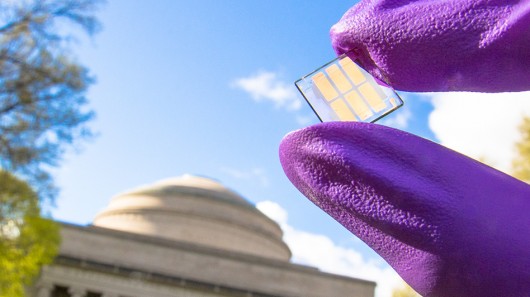
Flexible, inexpensive, large-area, lightweight solar cells are difficult to produce as they require an inert atmosphere and high temperatures, and they often degrade in a short time after exposure to air. Researchers at MIT, however, have used a new method to craft solar cells from ultra-thin layers of quantum dots in a process that promises to avoid these problems, and at room temperature. At the same time, they have also set a new record of nine percent for the most efficient quantum-dot solar cells produced to date.

Flexible, inexpensive, large-area, lightweight solar cells are difficult to produce as they require an inert atmosphere and high temperatures, and they often degrade in a short time after exposure to air. Researchers at MIT, however, have used a new method to craft solar cells from ultra-thin layers of quantum dots in a process that promises to avoid these problems, and at room temperature. At the same time, they have also set a new record of nine percent for the most efficient quantum-dot solar cells produced to date.
This latest research builds on previous work by the Lester Wolfe Professor of Chemistry, Moungi Bawendi in producing quantum dots as thin, uniform coatings with accurately governed properties. Able to be applied to a range of materials, the tiny particles contained in the film are individually very efficient at turning light into electricity.
According to Vladimir Bulovic, Fariborz Maseeh Professor of Emerging Technology in MIT’s School of Engineering, bringing them together in thin coatings "allow them to do what they do as individuals – to absorb light very well – but also work as a group, to transport charges."
As a result of this arrangement, charges are transported across the film to be collected at the edges where they can then be used in a circuit to create an electric current. Although not yet as efficient as standard types of solar cells, with around nine percent of the light energy received by the cells being converted into electric current, it is the degree of improvement in this area in a short amount of time that is the notable aspect.
"Silicon had six decades to get where it is today, and even silicon hasn’t reached the theoretical limit yet," says Bulovic. "You can’t hope to have an entirely new technology beat an incumbent in just four years of development.”
However, it is the ease at which these quantum dots contained in a film are created which is the most impressive aspect of the work to date. Untold opportunities to apply thin, uniform coatings of electricity-generating quantum dots over surfaces – all without the creation limitations of traditional solar cells in regard to atmosphere, degradation, and temperatures – open up potential for consumer, military, and aerospace product manufacture.

 Previous page
Previous page Back to top
Back to top







